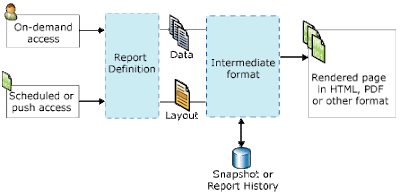2.Open the Class declaration by right clicking on it and selecting View code.
7. Create a main method and write the following code:
public static client void
main(Args args)
{
//define the new object
for controller class
SSRSTestController
ssrsTestController;
ssrsTestController = new
SSRSTestController();
//pass the caller args to
the controller
ssrsTestController.parmArgs(args);
//set the report name and
report design to run
ssrsTestController.parmReportName(ssrsReportStr(SSRSSessionQuery,Design));
//execute the report
ssrsTestController.startOperation();
}
>> Back to UI-BUILDER:
8. Based on different scenarios, different methods are overridden as shown:
public void build()
{
DialogGroup dlgGrp;
//get the current dialog
Dialog dlg =
this.dialog();
//make required modifications to the dialog
dlgGrp = dlg.addGroup('Dates');
dlgGrp.columns(2);
dlg.addField(identifierStr(FromDate));
dlg.addField(identifierStr(ToDate));
dlgGrp = dlg.addGroup('Customer');
dlg.addField(identifierStr(CustAccount));
}
also use this code in build method to bind data:
//get the report data contract object
contract = this.dataContractObject();
//associate
dialog field with data contract method
this.addDialogField(methodStr(SSRSTestContract,parmCustAccount), contract);
9.Over-ride a lookup method:
public void lookupCustAccount(FormStringControl _formStringControl)
{
Query query = new Query();
QueryBuildDataSource
DS;
SysTableLookup sysTablelookup;
//create a table
lookup
sysTablelookup
= SysTableLookup::newParameters(tableNum(CustTable),_formStringControl);
sysTablelookup.addLookupfield(fieldNum(CustTable,AccoutNum));
//create
a query
DS = query.addDataSource(tableNum(CustTable));
DS.addRange(fieldNum(CustTable,AccoutnNum)).value('001');
//assign
the query and call lookup
sysTablelookup.parmQuery(query);
sysTablelookup.performFormLookup();
}
10.Now override the postBuild method:
public void postBuild()
{
DialogField dlgCustGroup;
super();
//get the field to override by providing
the data contract object and the associated
attribute/method
dlgCustGroup
= this.bindInfo().getDialogField(this.dataContractObject(),
methodStr(SSRSTestContract,parmCustAccoutn));
//register the method we want to override
dlgCustGroup.registerOverrideMethod(
methodStr(FormStringControl,
lookup),
methodStr(SSRSTestUIBuilder,lookupCustAccount),this);
}
>> RDP(Report data provider):
Now create a class called TestDemoDP class, note that the name of the class must end with 'DP'.
(i) class declaration:
public TestDemoDP ()
{
# define the required variables
TempTable tmpTable;
}
(ii) getTemporaryTable(): Here you need to create a temporary table (Go to AOT create a table and name it ''TempTable' and set the Table Type property as 'TempDB')
public TempTable getTemporaryTable()
{
select * from tmpTable;
return tmpTable;
}
(iii) processReport():
public void processReport()
{
//Define Contract method
//write the business logic as per scenarios
while select AccountNum from custTable
where custTable.AccountNum == '001';
{
//insert into temp table
tmpTable.AccountNum = custTable.AccountNum;
tmpTable.insert()l
}
}
Now you are ready with the fully loaded SSRS report which contains UI-Builder,contract,controller,and DP class.
Note: After having created all these you need to create design in visual studio and connect these code there.For more information refer my earlier blogs on SSRS reports.







